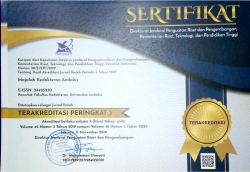Slipped Capital Femoral Epiphysis (SCFE)
Abstract
Keywords
Full Text:
PDFReferences
Gholve PA, Cameron DB, Millis MB. Slipped capital femoral epiphysis update. Curr Opin Pediatr. 2009;21(1):39-45.
Otani T, Kawaguchi Y, Marumo K. Diagnosis and treatment of slipped capital femoral epiphysis : Recent trends to note. J Orthop Sci. 2018;1–9.
Tannast M, Jost LM, Lerch TD, Schmaranzer F, Ziebarth K, Siebenrock K-A. The modified Dunn procedure for slipped capital femoral epiphysis: the Bernese experience. J Child Orthop. 2017;11(2):138–46.
Umans H, Liebling MS, Macy NJ, Pritzker HA. Slipped capital femoral epiphysis : a physeal lesion diagnosed by MRI, with radiographic and CT correlation. 1998;139–44.
Peck K, Herrera-soto J. Slipped Capital Femoral Epiphysis : What’s New ? Orthop Clin NA. 2014;45(1):77–86.
Peck D. Slipped Capital Femoral Epiphysis: Diagnosis and Management. Am Fam Physician. 2010; 82(3):258-62.
Millis MB. SCFE : clinical aspects , diagnosis , and classification. J Child Orthop. 2017;11(2):93-98.
May C, Spencer S. The Pediatric Femur: Development, Growth, and Surgical Anatomy. In: Pediatric Femur Fractures. Springer; 2016. p. 1–25.
American Academy of Orthopaedic Surgeons. Slipped Capital Femoral Epiphysis.Diakses pada 5 Mei 2019. Tersedia dari: https://orthoinfo.aaos.org/en/diseases--conditions/slipped-capital-femoral-epiphysis-scfe date: 22/2/19)
Loder RT, Aronsson DD, Weinstein SL, Breur GJ, Ganz R, Leunig M. Slipped capital femoral epiphysis. Instr Course Lect. 2008;57:473–98.
Sankar WN, Vanderhave KL, Matheney T, Herrera-Soto JA, Karlen JW. The modified Dunn procedure for unstable slipped capital femoral epiphysis: a multicenter perspective. JBJS. 2013;95(7):585–91.
Murray AW, Wilson NIL. Changing incidence of slipped capital femoral epiphysis: a relationship with obesity? J Bone Joint Surg Br. 2008;90(1):92–4.
Nourbakhsh A, Ahmed HA, McAuliffe TB, Garges KJ. Case Report. Clin Orthop Relat Res. 2008;466(3):743–8.
Papavasiliou KA, Kirkos JM, Kapetanos GA, Pournaras J. Potential influence of hormones in the development of slipped capital femoral epiphysis: a preliminary study. J Pediatr Orthop B. 2007;16(1):1–5.
Houghton KM. Review for the generalist: evaluation of pediatric hip pain. Pediatr Rheumatol. 2009;7(1):10.
Peck D, Peck D. Slipped capital femoral epiphysis: diagnosis and management. Am Fam Physician. 2010;82(3):258–62.
Witbreuk MM, van Royen BJ, Van Kemenade FJ, Witte BI, van der Sluijs JA. Incidence and gender differences of slipped capital femoral epiphysis in the Netherlands from 1998–2010 combined with a review of the literature on the epidemiology of SCFE. J Child Orthop. 2013;7(2):99–105.
Gutman IM, Gilbert SR. Trends in slipped capital femoral epiphysis: is the rate declining? J Child Orthop. 2018;12(5):428–33.
Schur MD, Andras LM, Broom AM, Barrett KK, Bowman CA, Luther H, et al. Continuing delay in the diagnosis of slipped capital femoral epiphysis. J Pediatr. 2016;177:250–4.
Brenkel IJ, Dias JJ, Davies TG, Iqbal SJ, Gregg PJ. Hormone status in patients with slipped capital femoral epiphysis. J Bone Joint Surg Br. 1989;71(1):33–8.
Kennedy JG, Hresko MT, Kasser JR, Shrock KB, Zurakowski D, Waters PM, et al. Osteonecrosis of the femoral head associated with slipped capital femoral epiphysis. J Pediatr Orthop. 2001;21(2):189–93.
Loder RT, Starnes T, Dikos G, Aronsson DD. Demographic predictors of severity of stable slipped capital femoral epiphyses. JBJS. 2006;88(1):97–105.
Riad J, Bajelidze G, Gabos PG. Bilateral slipped capital femoral epiphysis: predictive factors for contralateral slip. J Pediatr Orthop. 2007;27(4):411–4.
Lim YJ, Lam KS, Lee EH. Review of the management outcome of slipped capital femoral epiphysis and the role of prophylactic contra-lateral pinning re-examined. Ann Med Singapore. 2008;37(3):184.
Stasikelis PJ, Sullivan CM, Phillips WA, Polard JA. Slipped capital femoral epiphysis. Prediction of contralateral involvement. JBJS. 1996;78(8):1149–55.
Krahn TH, Canale ST, Beaty JH, Warner WC, Lourenco P. Long-term follow-up of patients with avascular necrosis after treatment of slipped capital femoral epiphysis. J Pediatr Orthop. 1993;13(2):154–8.
Gautier E, Ganz K, Krügel N, Gill T, Ganz R. Anatomy of the medial femoral circumflex artery and its surgical implications. J Bone Joint Surg Br. 2000;82(5):679–83.
Loder RT. Unstable slipped capital femoral epiphysis. J Pediatr Orthop. 2001;21(5):694–9.
Parsch K, Weller S, Parsch D. Open reduction and smooth Kirschner wire fixation for unstable slipped capital femoral epiphysis. J Pediatr Orthop. 2009;29(1):1–8.
Otani T, Kawaguchi Y, Fujii H, Ueno Y, Hayama T, Murakami H, et al. Prevention of femoral head avascular necrosis in the treatment of unstable SCFE; open reduction method instead of closed manual reduction. Nihon Shouni Seikeigeka Gakkai Zasshi (J Jpn Ped Orthop Ass). 2015;24(1):23–8.
Popejoy D, Emara K, Birch J. Prediction of contralateral slipped capital femoral epiphysis using the modified Oxford bone age score. J Pediatr Orthop. 2012;32(3):290–4.
Dunn DM. The treatment of adolescent slipping of the upper femoral epiphysis. J Bone Joint Surg Br. 1964;46(4):621–9.
Persinger F, Klingele KE. Treatment of Unstable Versus Stable Slipped Capital Femoral Epiphysis Using the Modified Dunn Procedure. J Pediatr Orthop. 2017;
Upasani V V, Birke O, Klingele KE, Millis MB, Group ISS. Iatrogenic hip instability is a devastating complication after the modified Dunn procedure for severe slipped capital femoral epiphysis. Clin Orthop Relat Res. 2017;475(4):1229–35.
Palocaren T, Holmes L, Rogers K, Kumar SJ. Outcome of in situ pinning in patients with unstable slipped capital femoral epiphysis: assessment of risk factors associated with avascular necrosis. J Pediatr Orthop. 2010;30(1):31–6.
Loder RT, Richards BS, Shapiro PS, Reznick LR, Aronson DD. Acute slipped capital femoral epiphysis: the importance of physeal stability. JBJS. 1993;75(8):1134–40.
Chen RC, Schoenecker PL, Dobbs MB, Luhmann SJ, Szymanski DA, Gordon JE. Urgent reduction, fixation, and arthrotomy for unstable slipped capital femoral epiphysis. J Pediatr Orthop. 2009;29(7):687–94.
Lubicky JP. Chondrolysis and avascular necrosis: complications of slipped capital femoral epiphysis. J Pediatr Orthop B. 1996;5(3):162–7.
Carney BT, Weinstein SL, Noble J. Long-term follow-up of slipped capital femoral epiphysis. J Bone Joint Surg Am. 1991;73(5):667–74.





















